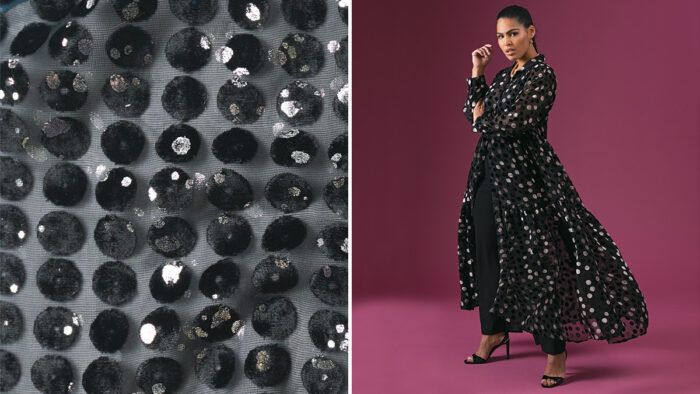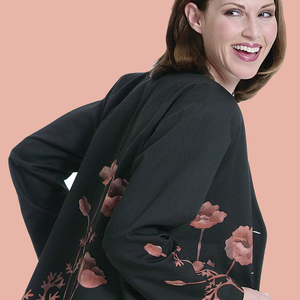Sewing Techniques for Burn-Out Fabrics
Handle these thick—and thin—textiles properly
Burn-out fabrics feature a sheer ground with opaque, often textured motifs. The name comes from the traditional technique for creating the velvet-on-silk variety, a blended textile in which the ground fabric is a different fiber type than the pile. A rayon-dissolving weak acid solution is applied to silk/rayon-blend velvet, burning away select areas and leaving behind a pattern of velvet motifs on silk chiffon. The chemically created fabric is also known as devoré, from the French for “devoured,” because the velvet pile is eaten away by the applied chemicals. This fabric type is sometimes referred to as wedding ring velvet because, despite the velvet’s texture, the width of the fine fabric can be slipped through a wedding ring. It results in flowing garments with a luxurious hand and prints with color and dimension.
Burn-out today also refers to a broader group of textiles with a similar finished effect of an opaque and/or textured motif on a sheer ground. Burn-out jacquards feature motifs from thicker fibers woven into a see-through background fabric. These fabrics may be from varied fibers, such as cotton, linen, lamé, silk, and others in assorted combinations since there is no chemical process used to create the textile.
Burn-out fabrics can be delicate and deserve special care and sewing to realize the fabric’s potential and ensure long-lasting garments. These textiles are suitable for loose-fitting styles in which the fabric can move and flow. Consider strategic lining or accompanying undergarments to enhance the fabric’s sheer areas in tops, full pants, and skirts; tank- or slip-style dresses; and dresses with drape features.
Preparation and cutting
Depending on the fiber content, this fabric can be machine-washed and machine-dried on the gentle cycle. Metallic variations should be treated according to the manufacturer’s instructions.
Preshrink: If you plan to dry-clean the fabric, preshrink it first by hovering a steam iron 1/2 inch above its surface.
Pressing: Use a dry iron on the silk setting, or the appropriate setting for the fiber type. For burn-out textiles with a fiber mix, set the iron to accommodate the fiber that accepts less heat.
Layout: Use a double-thickness, with-nap layout. Bias cuts are unstable in this fabric unless you have a lot of experience. To control fabric and cut accurately, cover the table with tissue paper. Pin the double thickness of fabric to the paper with the right sides out. Pin the pattern pieces, with the nap going down the garment, through all thicknesses. Keep the pins within the seam allowances.
Cutting: With sharp scissors, cut through all layers, including the tissue paper. Micro-serrated shears work well.
Appropriate notions

Work with notions that suit the dual characteristics of burn-out fabrics: the sheer and delicate areas as well as opaque and dimensional areas.
Marking: Use a Clover Chaco Liner or tailor’s tacks. Waxed chalk stains silk. A Clover white marking pen works on dark colors.
Interfacing and lining: Silk organza. For less transparency, silk georgette is a good lining choice.
Thread: Fine cotton machine-embroidery thread.
Needle: 60/8 or 65/9 microtex or sharp.
Presser foot: There is a danger of the thin fabric being pushed or drawn into the area under the throat plate. To prevent this, install a straight-stitch presser foot and single-hole throat plate. Or use a satin/zigzag stitch presser foot and throat plate and switch the needle position to far left for more support from three sides.
Temporary stabilizer: Another option to prevent the fabric catching in the throat plate is to place a strip of adding machine tape beneath the seam. Tear the paper out of the stitches after sewing.
Technique advice
Burn-out fabrics vary in thickness, so feed fabric smoothly under the presser foot and monitor stitch quality.
Select a stitch length and seam finish: Set your sewing machine to sew a 2.0-mm straight stitch. Sew any long vertical seams with a narrow zigzag (0.5-mm width, 2.5-mm length) to allow seams to relax. Sew narrow French seams for clean results on this partially sheer textile.
Push the fabric: Use a credit card in front of the presser foot to push the fabric toward the needle. Hold the card so it slants up from the machine bed, with its long edge perpendicular to the stitching line.
Mix fabrics with care: When joining burn-out to other fabrics, sew with the burn-out on the bottom.
Avoid topstitching: It is not recommended, as it is difficult to predict and control precision stitching on the varying textures of burn-out.
Choose appropriate closures: Fabric loops or machine buttonholes sewn with fine machine embroidery thread work fine. Stabilize seam allowances at zipper openings with silk organza strips. Hand-picked zippers are the most compatible with this fabric.
Hem carefully: Use fusible thread in the bobbin and fine thread in the needle. Trim the hem allowance to 1/2 inch. With the fabric right side up, staystitch along the hemline. Press the hem allowance to the wrong side, melting the fusible thread and forming a sharp crease. Trim the hem allowance to 1/8 inch. Then hand-roll the hem, enclosing the raw edge. Hand-sew or machine-sew with fine thread. If the hem stretches as you stitch, apply pressure with your finger just behind the presser foot.
Sandra Betzina is the author of All New Fabric Savvy (The Taunton Press, 2017), from which this article is adapted.
































Log in or create an account to post a comment.
Sign up Log in